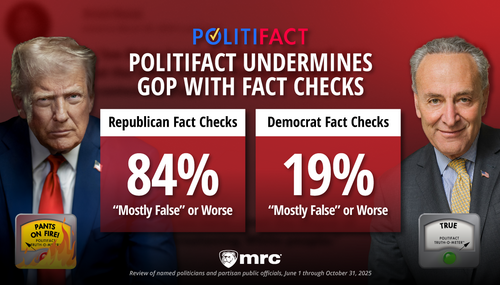
The upcoming-battle story was provided Sunday by Peter Baker and Carl Hulse, "G.O.P. Weighs Political Price Of Court Fight," complete with the paper's usual ideological imbalance. A sampling:
....some conservatives who led the fight against Justice Sonia Sotomayor's confirmation last year said they should learn from mistakes made then, like making grand claims about raising vast sums of money only to find that Republican senators were not as committed to an all-out battle.In all, there were eight conservative labels compared to just two liberal ones.
"We will all be laughed at -- including laughed at by Republican senators -- by raising the war cries too loud and too early, when in fact the senators will not deliver what we are promising," said Manuel Miranda of the Third Branch Network, who organizes regular conference calls of like-minded conservatives about judicial nominations. Instead, he said, conservatives should take a more "modest" and "measured" approach at first.
Mr. Obama appears to be leaning toward choices intended to avoid provoking Republicans. Still, any Supreme Court vacancy energizes the most committed advocates on both sides, particularly over issues like abortion, guns and religion.
The Family Research Council, a leading conservative group, sent an alert to members on Friday and will ask supporters to begin contacting senators. "If he selects someone with a radical judicial philosophy, the fabric of our already divided country will be torn even more," Tony Perkins, the group's president, said in an interview.
Supreme Court reporter Adam Liptak's Saturday front-page story on Justice Stevens, "From Age of Independence to Age of Ideology," didn't emphasize Stevens' liberalism but his opinion that the court had shifted to the right:
In an interview last week, he said that every one of the dozen justices appointed to the court since 1971, including himself, was more conservative than his or her predecessor.Liptak could have easily challenged Stevens on the "possible exception" of Ginsburg, an ACLU liberal. Ginsburg replaced Justice Byron White in 1993, one of two justices who voted against the Roe v. Wade abortion decision, while Ginsburg was an energetic abortion advocate, as noted by my colleague Tim Graham at Newsbusters.
"We'll wait and see to see if the most recent change fits that," he said of Justice Sonia Sotomayor, who joined the court last year. "But prior to Sonia's joining the court that was true with the possible exception of Ruth Ginsburg."
Liptak put a positive spin on the fact that Stevens, a liberal justice, often proposed limits on free speech, and learned that Stevens could see "the humanity" in the people whose cases came before the court. That must have come in handy.
He has not taken a categorical approach in free speech cases and has instead adjusted the level of First Amendment protection to the value of the speech in question. He wrote the majority opinion in F.C.C. v. Pacifica Foundation that said the government could ban the broadcast of the comedian George Carlin's "seven dirty words" monologue. And he dissented from a 1989 decision that gave First Amendment protection to flag burning.Also on Saturday's front page, the lead story on Stevens's retirement by Sheryl Gay Stolberg and Charlie Savage fed the media cliche of a right-wing Supreme Court (an idea challenged by some of that court's actual decisions, like the one giving the executive branch authority to regulate carbon dioxide):
He has been alert to the humanity of the people whose cases made their way to the court. In a 1984 dissent, he objected to a ruling that said prisoners had no privacy rights even if guards undertook searches to harass them.
His leaving will not, however, change the composition of the court; although he was appointed in 1975 by President Gerald R. Ford, a Republican, he has become one of its most reliably liberal members during his nearly 35-year tenure, as the court drifted ever rightward.
And in a Sunday profile of Stevens, Linda Greenhouse, the paper's former liberal Supreme Court reporter, stretched to paint Stevens as having a "conservative bent" on the death penalty and other issues, at least in his early years on the bench, and at the end praised Stevens as a justice "willing to learn something on the job."
Greenhouse's evidence of Stevens' "conservative bent": He once opposed affirmative action and taxpayer funding of abortion.
Six months after joining the court, Justice Stevens wrote one of a trio of opinions by which the court changed course and upheld a new generation of state death-penalty laws. The new justice demonstrated a conservative bent on other issues as well. He opposed affirmative action in several high-profile cases, including the Bakke decision in 1978 In an early post-Roe set of decisions, he voted against requiring the government to pay for abortions for women who could not afford them.
Greenhouse's initial try to make Stevens a death-penalty conservative turned out to be exaggerated, as this online correction indicated:
An earlier version of this Op-Ed essay misstated the number of major death-penalty opinions Justice John Paul Stevens wrote six months after joining the Supreme Court. It was one, not three.




